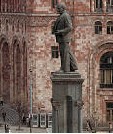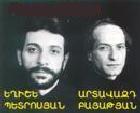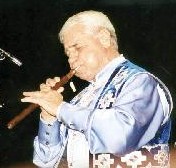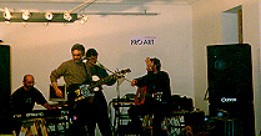Part
III. Seventies |
--We're peeking from inside the iron
curtain to the world around |
...Yerevan Yerevan - im yar otevan
Es kantsnem, kgnam du aprir havityan...
...Yerevan serdcu blizok i dorog
Yerevan - eto bolshe chem gorod...
...Misht hpart du eghir, misht hervic kanchir
Hayastan im sirun Hayastan...
...Aystegh em tsnvel es,
aystegh metsatsel
Ays jure xmel sarnorak
|

 |
| End of 70's. The whole planet Earth is grooving to the
charming rhythms of a new musical era. Brought in by Bee Gees,
ABBA and Boney M reggae sounds, this new generation occupied
every single house in the world. That was the disco movement.
Soon after, with a blazing lightning speed, everyone was
humming to ABBA's "Dancing Queen", to African Simon's beats,
to Baccara and Bee Gees. Italian disco grew in popularity too.
Adriano Celentano, Toto Cutugno and the beautiful Italian
blonde Rafaella Carra were dominating on Soviet late night TV
shows. And what about the famous Sanremo festivals attracting
more attention that nowadays Oscar's ceremony? The disco era
triggered the first wave of international records being
imported into the USSR as the sole country-wide recording
company "Melodia" kept releasing new LPs attempting to satisfy
the hungry public demands. Especially popular were the
compilation records containing anything from Celentano's
"Soli" and BoneyM's "Sunny" to Leo Seyer and even her majesty
Alla Pugacheva, the first and only Russian singing diva.
Bingo! The ice has been melted. Even some of the "no-no" bands
of the decaying capitalist world were able to burst through.
If you browsed through Soviet record compilations in late
70's, there was a slight chance that you might find a song or
two by Led Zeppelin, Uriah Heep or Status Quo. A few times
"Stairway to heaven" and Purple's "Smoke on the water" were
unexpectedly broadcasted on air waves accompanied by "Veselie
rebyata" and Sophia Rotaru. |
| A dynamic duo
"Ardzagank" which ruled Armenian airwaves in 70's and 80's
made a successful comeback after almost ten years of hiatus,
in 1994 with an album called "Eyes on me" (nothing to do with
Tupac Shakur's song by the way). Later on they launched
"Ardzagank" recording studio in Yerevan Concert Hall with one
goal: to discover young new talents.
Photo: "Ardzagank"
duo with Yegishe Petrosian and Artavazd
Bayatian |
 |
So what exactly was going on at the Armenian rock stage at that
curious period of time? Surely the western influence was way too
high, therefore for a while Armenian public was admiring the newly
found love in music with an awe. Pop-music bands like "Ardzagank",
"36/6", and some *estrada* solo artist singing about their orgasmic
love to the motherland were the ones gaining 100% of the public's
eye. Music of folk and light pop stars was warmly greeted by the
Sovietized public. National music surely posed no threat to the
censure, thus was widely accepted and promoted.
When I grow tired of myself
And when I have no more questions to ask
I will go out and walk aimlessly on the streets
Or pehaps visit homes of my old friends
Doors will open one by one in front of me
I will see faces I have known all my life
Some have changed into mourning
While others - into celebration
"Ardzagank" - "They don't wait for me"
Memories of love descend upon me
I would like not to remember you,
Not to remember.. But I cannot
You have to be near me, you have to be near me
And cast your light upon my soul
Jivan Gasparyan - "Memories of love"
|
Listen to Ardzagank's music:
Listen to Jivan Gasparyan's music:
|
 |
Many national
musicians and artists like Rouben Matevosian claimed a lot of
popularity with Armenian folklore songs. Instrumental music
performed on duduk, saz or kyamancha was also popular.
Ubiquitous Armenian violin with its distinct sound made folk
music jump from sadness to happiness in a second. Such were
crafty "Hye Zhogovdrakan" musicians. Jivan Gasparyan's name
definitely stands out as the "Father of Armenian duduk". In
1973 Jivan Gasparyan becomes the first musician to receive the
title of "People's Artist of Armenia" ("Zhogovrdakan artist")
by the government. Later he becomes the Gold Medal winner at
four UNESCO world-wide competitions and collaborates with
stars like Peter Gabriel and Michael Brooks. But more than
that, Jivan Gasparyan was the first one to make Armenian
folklore music recognized by the world.
Photo: Jivan Gasparyan with his magical
duduk |
But at the same time something else brewing deep deep
underground. Those were the pioneer Armenian hard rock bands, the
morlocks of their time. Picking up where "Apostles" left off, the first rock bands started
performing in small clubs for a dedicated audience of rock lovers.
The bands which usually lasted for only one show and performed
extemporaneous concerts would later give birth to "Vostan Hayots",
"Asparez", "Ayas", "Aspet" and other real pioneers... The most
popular concert spot for these moth-lived bands was the famous
"Green hall" ("Kanach zal") at Yerevan Politechnic Institute. A lot
of times such shows had to be cancelled due to a fear of wide
student movements. But young musicians and art lovers would always
find another place of gathering. Still, Green hall was a relatively
liberal spot and best of all, it was free for students of
Politechnic Institute. Needless to say, the majority of the crowd
were students. Politechnic's Green hall would remain a popular place
for many years to come, and even in 90's a couple of famous
Gaudeaumus festivals were held in there.
Most of the music followers were artists by nature. Some of the
places they used to gather and talk about arts were Yerevan's
Derasan Kafe, Skvoznyachok and of course the well-known Teymurnots
bar where you could have fried potatoes with a glass of Zhigulevskiy
beer. Such gatherings along with impromptu concerts, small shows
created a very unique artistic atmosphere in Yerevan. That was the
time when the capital of Armenia was prospering and blooming both in
architectural and spiritual sense.
 |
Suddenly
Arthur Meschian re-appeared in the musical scene out of
nowhere reassembling the "Apostles" with a whole new lineup. This
time he teamed up with young artists Vahan Artsruni and Gurgen
Melikian. Although the band would never reach the same heights
as the old Apostles,
their shows would still attract a lot of crowd. The
re-emergence of "Apostles" also brought in new names to the
Armenian rock stage. Fresh from university, the new bands and
artists quickly took over the apostolic legacy.
Photo: The New Apostles - Arthur Meschian,
Gurgen Melikian and Vahan Artsruni at an impromptu show in RMA
office, 1997 |
<<
Previous | Next
>>
Copyright ® Razbirat.com2002
Hosted by Rockar.narod.ru2003
|